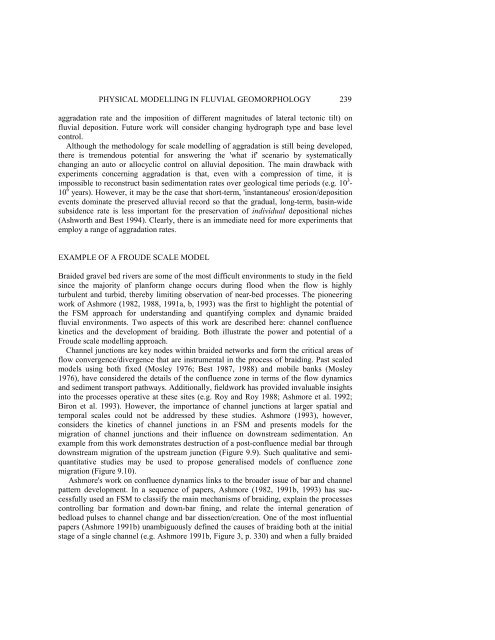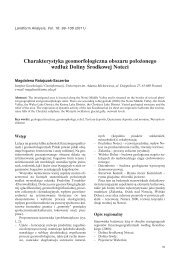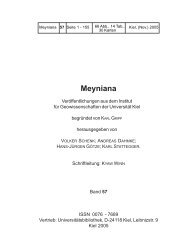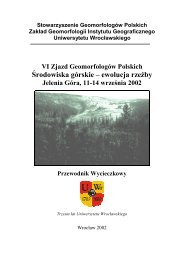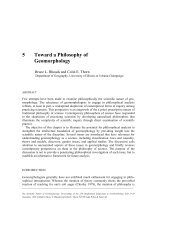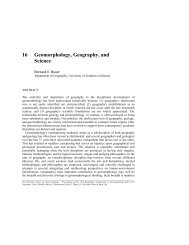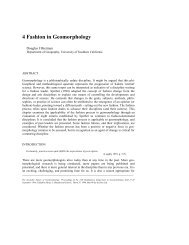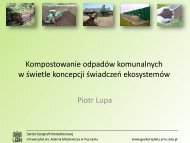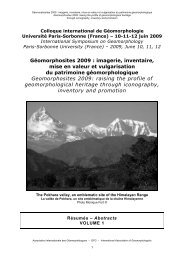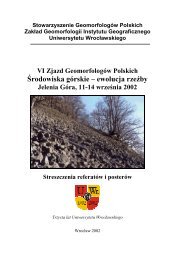Physical Modelling in Fluvial Geomorphology
Physical Modelling in Fluvial Geomorphology
Physical Modelling in Fluvial Geomorphology
Create successful ePaper yourself
Turn your PDF publications into a flip-book with our unique Google optimized e-Paper software.
PHYSICAL MODELLING IN FLUVIAL GEOMORPHOLOGY 239<br />
aggradation rate and the imposition of different magnitudes of lateral tectonic tilt) on<br />
fluvial deposition. Future work will consider chang<strong>in</strong>g hydrograph type and base level<br />
control.<br />
Although the methodology for scale modell<strong>in</strong>g of aggradation is still be<strong>in</strong>g developed,<br />
there is tremendous potential for answer<strong>in</strong>g the 'what if' scenario by systematically<br />
chang<strong>in</strong>g an auto or allocyclic control on alluvial deposition. The ma<strong>in</strong> drawback with<br />
experiments concern<strong>in</strong>g aggradation is that, even with a compression of time, it is<br />
impossible to reconstruct bas<strong>in</strong> sedimentation rates over geological time periods (e.g. 10 3 -<br />
10 6 years). However, it may be the case that short-term, '<strong>in</strong>stantaneous' erosion/deposition<br />
events dom<strong>in</strong>ate the preserved alluvial record so that the gradual, long-term, bas<strong>in</strong>-wide<br />
subsidence rate is less important for the preservation of <strong>in</strong>dividual depositional niches<br />
(Ashworth and Best 1994). Clearly, there is an immediate need for more experiments that<br />
employ a range of aggradation rates.<br />
EXAMPLE OF A FROUDE SCALE MODEL<br />
Braided gravel bed rivers are some of the most difficult environments to study <strong>in</strong> the field<br />
s<strong>in</strong>ce the majority of planform change occurs dur<strong>in</strong>g flood when the flow is highly<br />
turbulent and turbid, thereby limit<strong>in</strong>g observation of near-bed processes. The pioneer<strong>in</strong>g<br />
work of Ashmore (1982, 1988, 1991a, b, 1993) was the first to highlight the potential of<br />
the FSM approach for understand<strong>in</strong>g and quantify<strong>in</strong>g complex and dynamic braided<br />
fluvial environments. Two aspects of this work are described here: channel confluence<br />
k<strong>in</strong>etics and the development of braid<strong>in</strong>g. Both illustrate the power and potential of a<br />
Froude scale modell<strong>in</strong>g approach.<br />
Channel junctions are key nodes with<strong>in</strong> braided networks and form the critical areas of<br />
flow convergence/divergence that are <strong>in</strong>strumental <strong>in</strong> the process of braid<strong>in</strong>g. Past scaled<br />
models us<strong>in</strong>g both fixed (Mosley 1976; Best 1987, 1988) and mobile banks (Mosley<br />
1976), have considered the details of the confluence zone <strong>in</strong> terms of the flow dynamics<br />
and sediment transport pathways. Additionally, fieldwork has provided <strong>in</strong>valuable <strong>in</strong>sights<br />
<strong>in</strong>to the processes operative at these sites (e.g. Roy and Roy 1988; Ashmore et al. 1992;<br />
Biron et al. 1993). However, the importance of channel junctions at larger spatial and<br />
temporal scales could not be addressed by these studies. Ashmore (1993), however,<br />
considers the k<strong>in</strong>etics of channel junctions <strong>in</strong> an FSM and presents models for the<br />
migration of channel junctions and their <strong>in</strong>fluence on downstream sedimentation. An<br />
example from this work demonstrates destruction of a post-confluence medial bar through<br />
downstream migration of the upstream junction (Figure 9.9). Such qualitative and semiquantitative<br />
studies may be used to propose generalised models of confluence zone<br />
migration (Figure 9.10).<br />
Ashmore's work on confluence dynamics l<strong>in</strong>ks to the broader issue of bar and channel<br />
pattern development. In a sequence of papers, Ashmore (1982, 1991b, 1993) has successfully<br />
used an FSM to classify the ma<strong>in</strong> mechanisms of braid<strong>in</strong>g, expla<strong>in</strong> the processes<br />
controll<strong>in</strong>g bar formation and down-bar f<strong>in</strong><strong>in</strong>g, and relate the <strong>in</strong>ternal generation of<br />
bedload pulses to channel change and bar dissection/creation. One of the most <strong>in</strong>fluential<br />
papers (Ashmore 1991b) unambiguously def<strong>in</strong>ed the causes of braid<strong>in</strong>g both at the <strong>in</strong>itial<br />
stage of a s<strong>in</strong>gle channel (e.g. Ashmore 1991b, Figure 3, p. 330) and when a fully braided


